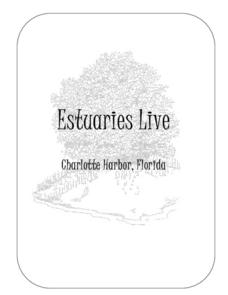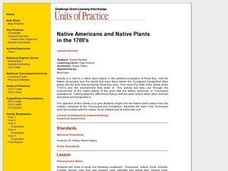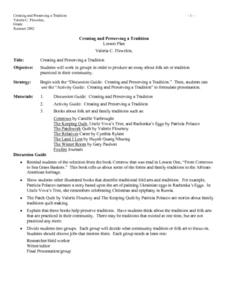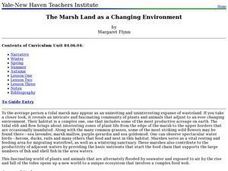Curated OER
Sea to Sky Adjectives Booklet
Adjectives build better sentences! First, second, third, and fourth graders design adjective booklets that feature words to describe everything between the sea and the sky.
Curated OER
Estuaries Live Charlotte Harbor, Florida
Students reorganize sentence strips into paragraphs to learn about seagrasses. They learn vocabulary and facts about sea grasses using the paragraphs once they are reconstructed. They continue their study with a number of associated...
Curated OER
Sea Level and the Terrapin
Students study the habitat of the terrapin. In this terrapin lesson, students create a diorama of the habitat of the terrapin. Students also simulate how it would look if people moved into the area and how predators can threaten terrapin...
Curated OER
Local Habitats
Learners create dioramas that depict a habitat. In this habitat lesson, students use a variety of art items to develop either a marine, freshwater/pond, or forest habitat in a box. They write an expository essay about their habitat, and...
Curated OER
Food Webs
Students research what food is eaten by the following organisms: penguins leopard seals, krill, elephant seals, petrels, albatross, fur seals, squid, insects and grass. They make a food web using the data they have gathered.
Curated OER
Home Sweet Home
Students explore marine turtle habitats. Students research one species of marine turtle found in the Gulf of Mexico. They identify plants and animals in the habitat. They create a model or replica using information gathered through their...
Curated OER
Paper Molas
Delve into the history of textile art using this resource. Learners discuss the history of molas, a type of textile art made in Panama and Columbia, and talk about the importance of this process in the Kuna culture. Then, they create...
Curated OER
Introduce Vocabulary: From Tadpole to Frog (Pfeffer)
Take an amphibious journey with budding readers as you explore vocabulary in Wendy Pfeffer's informative book From Tadpole to Frog. This text is the backdrop of a vocabulary exercise based on six words: fertilize,...
Polar Bears International
Top of the World
Learn about polar bears and the Arctic circle with a lesson about the countries and conditions of the region. After examining how the area differs from Antarctica, kids explore climates, animals, and geographical position...
Curated OER
Native Americans and Topography at Rose Bay
Students visit a wetland ecosystem. While they are there, students explore how to read topography maps of Rose Bay.
Curated OER
Camouflage, Protection, & Adaptations—Who am I?
Students explore ocean animal adaptations. In this animal adaptations lesson, students examine how different ocean animals use adaptations other than camouflage to protect themselves.
Curated OER
Native Americans and Native Plants
Students take a field trip to a native plant culture. They need to describe where the plants were before the Europeans occupied North America.
Curated OER
Food Webs
Students recognize interdependence in a food web by using yarn and notecards to create a food web and discussing what would happen if one of the organisms from a certain trophic level is removed.
Curated OER
Creating and Preserving a Tradition
Students explore folk art and tradition. They work in small groups and produce an essay about folk art or traditions practiced in their community. Students discuss the creation and preservation of a tradition. They discuss various...
Curated OER
Listening and Punctuation and Grammar, oh my!
A great way to practice listening, punctuation, and proper grammar is playing this great partner activity. Learners must work together to read and write different sentences.
Curated OER
History of the Current
Young scholars, in groups, collect information from the Internet about historical events surrounding the effects of the Gulf Stream current on ship travel. They compile a chart and answer assessment questions.
Curated OER
Our Earth Crossword Puzzle
In this earth's environment worksheet, learners use the 20 clues and their problem solving skills to correctly complete the crossword puzzle.
Curated OER
Salt Marsh in a Pan
Students create a model of a salt marsh to discover the impact of pollution and human activities on water-based habitats including bays and the ocean. They recognize the relationship between natural and developed areas. Students impact...
Curated OER
The Marsh Land as a Changing Environment
Sixth graders continue their examination of the state of Connecticut. After taking a field trip, they identify the types of birds, plants, invertebrates and vertebrates who make their home in the salt marshes. In groups, they identify...
Curated OER
Wild Arctic
Learners explore key terms, including food web and food chain. They discuss Arctic plants and animals, devise at least three Arctic food chains and create a food web showing connections among Arctic life.
Curated OER
Habitats and Adaptations
Students research and describe the habitat and adaptations of a reef animal. After the student is assigned a habitat, they design and draw a cresture adapted to eat each food and to live in each habitat.
Curated OER
Back to the Farm
Students complete a family tree. In this farming and ranching lesson plan, students define the term genealogy, learn how to create a family tree, and fill in a family tree with the help of their parents making sure to note if any...
Curated OER
Primary Producers
Students examine the role of carbon in the oceans and how phytoplankton determine the levels present. In groups, they practice measuring primary productivity using two methods. They use the internet to research the role of phytoplankton...
Curated OER
Food Webs
Students create a bulletin board display illustrating food chains they make from a list of ocean organisms. Students also play a game showing what happens when one of the organisms is removed from the food chain and how they are all...























